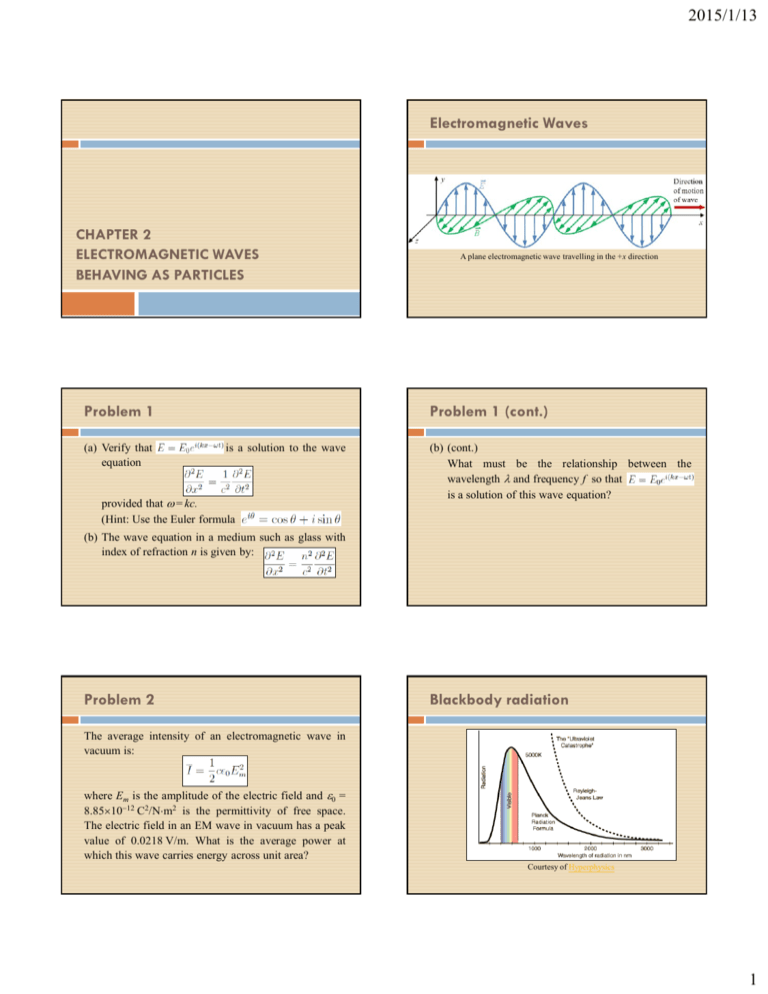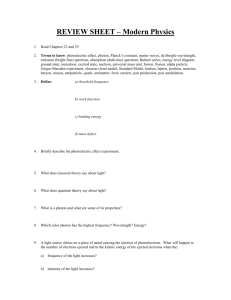Chapter 2 - Department of Physics, HKU
advertisement

2015/1/13 Electromagnetic Waves CHAPTER 2 ELECTROMAGNETIC WAVES BEHAVING AS PARTICLES A plane electromagnetic wave travelling in the +x direction Problem 1 (a) Verify that equation Problem 1 (cont.) is a solution to the wave provided that = kc. (Hint: Use the Euler formula (b) (cont.) What must be the relationship between the wavelength l and frequency f so that is a solution of this wave equation? ) (b) The wave equation in a medium such as glass with index of refraction n is given by: Problem 2 Blackbody radiation The average intensity of an electromagnetic wave in vacuum is: where Em is the amplitude of the electric field and e0 = 8.851012 C2/Nm2 is the permittivity of free space. The electric field in an EM wave in vacuum has a peak value of 0.0218 V/m. What is the average power at which this wave carries energy across unit area? Courtesy of Hyperphysics 1 2015/1/13 Blackbody radiation (Supplementary notes 1) Classical law of equipartition of energy states that if a system is in thermal equilibrium at the temp. T, Blackbody radiation (Supplementary notes 2) where a degree of freedom is a mode of energy possession. Since each standing EM wave in a cavity is created by an oscillating atom in the cavity wall, the average energy of the wave is E kT Conceptual question 1 By considering how to enable objects of unequal temperature to reach the same common temperature, explain why the electromagnetic waves enclosed in a cavity has the same temperature as that of the cavity walls. n 1,2,3, for an oscillating atom at frequency f. Hence, for the oscillating atoms in the cavity wall, Average energy 1 kT Degree of freedom 2 Planck’s suggestion: E nhf E EP ( E ) P( E ) e hf hf / kT 1 for the Boltzmann distribution P( E ) e E / kT / kT Note that P(E)dE is the probability for the system to have energy in the interval of E to E+dE. Conceptual question 2 What assumptions did Planck make in dealing with the problem of blackbody radiation? Discuss the consequences of these assumptions. Problem 3 Problem 4 Estimate the surface temperature of the Sun using the following information. The Sun’s radius is Rs = 7.0108 m. The average Earth-Sun distance is d = 1.51011 m. The power per unit area (at all frequencies) from the Sun is measured at the Earth to be Id = 1400 W/m2. Take the approximation that the Sun is a blackbody. (a) Show that the Planck formula can be expressed in terms of the wavelength l as: (b) Show that the Wiens displacement law can be derived from the spectral energy density dU/dl in part (a). 2 2015/1/13 Photoelectric effect Problem 5 An object of mass m = 2 kg is attached to a “massless” spring of force constant k = 25 N/m. The spring is stretched A = 0.40 m from its equilibrium position and released. (a) Find the total energy and frequency of oscillation according to classical calculations. (b) Assume that the energy of the system is quantized. Find the quantum number, n, for the system. (c) How much energy would be carried away by 1quantum change? Conceptual question 3 Consider the following photoelectric effect: characteristics f Courtesy of Hyperphysics Conceptual question 3 (cont.) of the (i) The generation of photoelectrons. (ii) The existence of a threshold frequency. (iii) The photoelectric current increases with increasing light intensity. (cont.) (v) The photoelectric current decreases slowly as V becomes much more negative. (vi) The stopping potential is independent of the light intensity. (vii) The photoelectric current appears almost instantly when the light is turned on. (iv) The photoelectric current is independent of anodecathode potential difference V for V > 0. Which of these cannot be explained by classical physics? Conceptual question 4 Conceptual question 4 (cont.) The figure on the left shows a typical current-versuspotential difference graph for a photoelectric effect experiment. (cont.) On the figure, draw and label curves for the following three situations: (ii) The light frequency is increased (iii) The cathode work function is increased. It is assumed that no other parameters of the experiment are changed in each case. (i) The light intensity (i.e. power per area) is increased. 3 2015/1/13 Problem 6 Problem 7 Consider a potassium surface that is at a distance d = 75 cm away from bulb of power P = 100 W. Suppose that the energy radiated by the bulb is 5% of the input power. Treating each potassium atom as a circular disk of radius r = 0.05 nm, determine the time required for an atom to absorb an amount of energy equal to its work function of f = 2.0 eV (1 eV = 1.6021019 J), according to the wave picture of light. When light of wavelength l1 = 450nm is incident on potassium, photoelectrons with stopping potential Vs,1 = 0.52 V are emitted. If the wavelength is changed to l2 300 nm, the stopping potential is Vs,2 = 1.90 V. Using only these numbers together with the values of the speed of light c and the electron charge e, (a) find the work function f of potassium and Conceptual question 5 Conceptual question 6 Suppose we produce X-rays not by smashing electrons into targets but by smashing protons, which are far more massive (but each with the same magnitude of charge as an electron). If the same accelerating potential difference were used for both, how would the cutoff wavelengths of the two X-ray spectra compare? Explain your answer. Why is it important to produce X-ray tubes with high accelerating voltages that are also able to withstand high electron currents? Problem 8 Problem 9 An electron with kinetic energy of K = 20 keV is brought to rest in a collision with a heavy nucleus. An electron accelerated to kinetic energy E = 50 keV in an X-ray tube has two successive collisions in being brought to rest in the target, emitting two bremsstrahlung photon in the process. The second photon has wavelength 0.095nm longer than the first one. (a) Calculate the frequency f of the photon produced by the collision. Assume the energy transfers to the heavy nucleus is negligible. (b) Show that momentum is not conserved in such collision. (b) compute a value of Planck's constant h. (a) What are the wavelengths of the two photons? (b) What is the kinetic energy of the electron after the emission of the first photon? 4 2015/1/13 Relativistic Energy and Momentum Compton Scattering To calculate the momentum and energy of a particle with speed v c, we must use relativistic formulas: Courtesy of Hyperphysics Conceptual question 7 Conceptual question 8 Must Compton scattering take place only between Xrays and free electrons? Can radiation in the visible region (say, a green light) undergo Compton scattering with a free electron? Why is the Compton effect unimportant in the transmission of television and radio waves? Problem 10 Problem 11 A 0.3 MeV X-ray photon makes a head-on collision with an electron initially at rest. An X-ray source of unknown wavelength is directed at a carbon sample. An electron is scattered with a speed of u = 4.5107 m/s at an angle of q = 60 relative to the motion of the original X-ray photon. Determine the wavelength of the X-ray source. (a) Using conservation of energy and momentum, find the recoil velocity of the electron u in terms of the speed of light c. (b) Check the velocity obtained in (a) agrees with the value determined from the Compton's formula. 5 2015/1/13 Conceptual question 9 Problem 12 An isolated atom can emit a photon and the atom's internal energy drops. This process is called spontaneous emission. Can an isolated electron emit a photon? Why or why not? A gamma-ray photon changes into a proton-antiproton pair. After creation, each of the pair moves off at 0.6c perpendicular to the motion of the photon. (a) Ignore momentum conservation, wavelength l of the photon. find the (b) Assume that this interaction occurs as the photon encounters a lead plate and that a lead nucleus participates in momentum conservation. What fraction of the photon's energy must be absorbed by the lead nucleus? Problem 13 Conceptual question 10 An electron with kinetic energy of Ke = 5 MeV undergoes annihilation with a positron that is at rest, producing two photons. One of the photons travels in the direction of the incident electron. Calculate the energy of each photon. A beam of photons passes through a block of matter. What are the three ways discussed in this chapter that the photons can lose energy in interacting with the material? Conceptual question 11 Conceptual question 12 You have a monoenergetic source of X-rays of energy 84 keV, but for an experiment you need 70 keV X-rays. How would you convert the X-ray energy from 84 to 70 keV? The intensity of a beam of light is increased but the frequency of the light is unchanged. As a result, (i) the photons travel faster. (ii) each photon has more energy. (iii) the photons are larger. (iv) there are more photons per second. Which of these (perhaps more than one) are true? Explain your answer. 6








